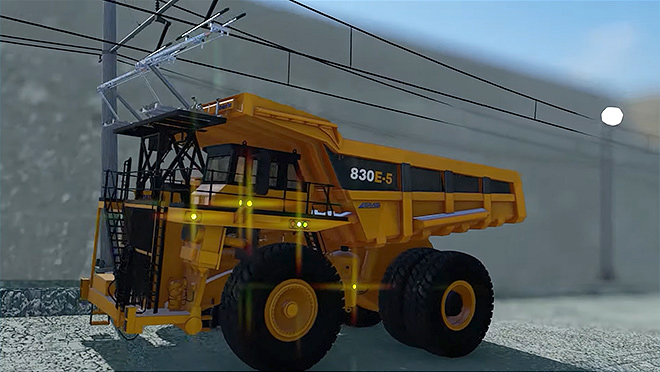Copper Mountain’s powerful first step towards net-zero mining

Environmental responsibility integral to the mine's operations
The Copper Mountain mine, located 20km south of Princeton in the Southern Interior, produces around 100 million pounds of copper equivalent per year.
Copper Mountain is aligned with the Paris Agreement and aims to reduce carbon intensity by up to 50% in five to seven years. It's also set an aggressive goal of net-zero greenhouse gas (GHG) emissions by 2035.
Electric trolley assist, a first in North America
The key step to achieving this goal was the installation of a 1 km-long section of electric trolley assist in 2021. The project is the first of its kind in North America, with seven full-size Komatsu 830E-5 hybrid trucks being commissioned in early 2022 to haul ore from the main pit to the primary crusher. An additional four trucks will be added in late 2022 for a total of 11.
Walt Halipchuk, Director of Sustainable Business Development at Copper Mountain, has overseen the project from its inception. "We first started exploring trolley assist back in December 2016," says Halipchuk. "Then in 2019, BC Hydro funded a feasibility study, and that's when it really shifted gears."
"We also secured funding for GHG projects from CleanBC the same year, along with a second grant in 2020," explains Halipchuk.
"We began by developing the ramp, moving eight million tons of material to build it. Obviously, we have the equipment right here at the mine to do that, and it moved along at a good pace, but with so many switchbacks along the roads in the mine, it was quite an undertaking."
Mining trucks powered by clean hydroelectricity
Meanwhile, the BC Hydro Interconnections team worked throughout 2021 to ensure that Copper Mountain can access the additional load needed to power the trolley assist project.
"I've had over 30 years' experience building mines in Peru, the Dominican Republic and northern B.C., but the Copper Mountain Haul Truck trolley assist project is one of the most challenging and rewarding projects I've ever done in my career," says Halipchuk. "We needed to integrate the needs of the mine both from an operational and sustainability perspective. The hybrid haul trucks and the critical electrical distribution infrastructure – they all have to work together perfectly."
The Komatsu hybrid trucks require three megawatts of peak power each, so understanding the electrical transmission system is vital. The trucks can only run on their electric drive motors when they're connected to the trolley assist on the mine ramp. This means the trolley has to seamlessly replace the power from a 2600 horsepower diesel engine while the truck is carrying 240 tonnes.
The finished trolley assist can deliver 12 megawatts at any one time – enough for four trucks to be hauling while the other seven are loading or unloading.
Lower GHGs and more stable costs, amongst the benefits of electrification
The Copper Mountain trolley assist project has cost around $40 million. There are also two further phases planned. Payback for all of them will come from a variety of factors:
- Emission reductions and protection from rising carbon taxes: As carbon taxes rise, the emission reductions from trolley assist will help to dramatically reduce Copper Mountain's liability. The first phase of Trolley Assist will reduce annual GHG emissions by roughly 14,000 tonnes.
- Rising diesel prices: Each Komatsu hybrid haul truck will displace 400 litres of diesel (or one tonne of CO2) per hour working via trolley assist. Plus, with the Transmission Tariff structure, moving to BC Hydro's clean electricity is a more stable energy costing model compared to relying on volatile diesel prices and supply.
- More production cycles: Even on the steep uphill mine ramp, the new hybrid trucks can travel at 20 km/h on electric power vs. 8 km/h when running on diesel. So Copper Mountain can haul more ore in less time.
- More responsible metals Work is well underway in B.C. to establish blockchain-style 'responsible metals' credentials that can be attached to appropriate products for transfer along the supply chain and to trade at a premium. Ultimately, this will make Copper Mountain's product more valuable on the global copper market.
Promoting mining electrification across Canada
As one of only two mines in the world with working electric trolley assist – the other is Boliden's Kevitisa mine in Finland – Copper Mountain are keen to spread the word about the benefits of electrification using clean energy. "This has gathered a lot of interest from other mining companies, especially in Canada," says Walt. "So we're planning a symposium for early 2022 to meet with other mining companies, share our learnings and promote the concept."
Copper Mountain also plans to hold an open day on May 25, 2022, during BC Mining Week. "People can come and see the trolley assist up close and join us for a big community day in Princeton town square. We encourage anyone interested in seeing the technology and wanting to learn about mining to come out and join us for the day," says Halipchuk.
In the meantime, Copper Mountain have also produced a short video showing the trolley assist in action.
Can we help you explore cutting edge efficiencies?
Whether you're trying to find efficiencies in a huge mine or a small workshop, if there's an emerging technology that you think could help to electrify your industry, contact your Key Account Manager or Regional Energy Manager, or call us at 604 522 4713 in the Lower Mainland or 1 866 522 4713 elsewhere in B.C.